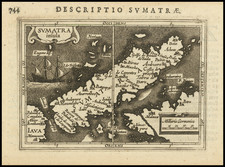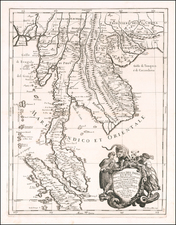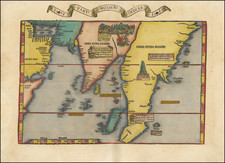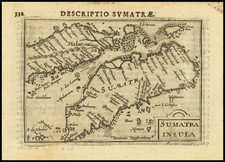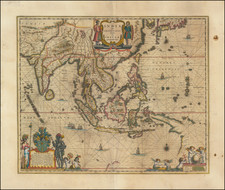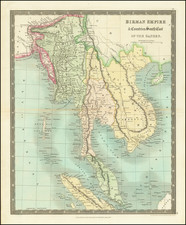The First Map To Name Keppel Harbor
Rare and important large scale hydrographic chart of Singapore's Keppel Harbor, based on the original surveys surveys made under the direction of Commander ArthurMostyn Field R N, September to October 1891, with the revised name of "Keppel Harbour" in honor of Henry Keppel in April 1900.
Keppel Harbor was named after Captain Henry Keppel, who surveyed what was then called the new harbor of Singapore. The New Harbor was largely created under his planning and completed in 1886. The harbor was originally simply known as New Harbor, but would be renamed Keppel Harbor by Sir James Alexander Swettenham, on April 19, 1900 when Admiral Keppel visited Singapore at the age of 92. Apparently, the decision to rename the harbor was not unanimously received, as is evidenced Reid's article entitled His Honour's folly : extracts from the "Straits Times," criticising Sir A. Swettenham's action in renaming the new harbour, Singapore, "Keppel Harbour." Singapore, Straits Times, 1900.
The chart extends from Keppel Harbour Singapore, to Brani Island and Sentosa and was first upated in 1893, apparently with the addition of the Keppel name for the first time.
The map pre-dates the conversion of antiquated wooden wharfs along Keppel Harbor into a modern deep-water container port, with granite docks and piers and automatic loading cranes. This massive development, which would continually be in process until World War II, would be the most important single project in Singapore's history, exponentially raising the harbor's tonnage capacity, ultimately making Singapore by far the leading port in Southeast Asia.
The Tanjong Pagar Dock Company's Wharves are shown, with the coal sheds immediately to the north, predating the creation of the Empire Dock. The T.P.L Co. Reclamation project is also shown, an area which would be dredged over the coming decades and would later house the Royal Singapore Yact Club..
Tanjong Pagar Dock Company
The Tanjong Pagar Dock Company, (1864–1905), the forerunner of today's Port of Singapore Authority, was founded by Guthrie and Company and Tan Kim Ching. The company was expropriated by the Government in 1905 who replaced it with the Tanjong Pagar Dock Board. In 1907 works were carried for the extension of Tank Road-Kranji Railway between Keppel Harbor and the town center, the Telok Ayer reclamation and the construction of the Offshore Mole, a granite-rubble breakwater, which created a second entrance to Singapore Harbour.
Admiral Sir Arthur Mostyn Field KCB FRS FRGS FRAS (1855-1950)
Mostyn enlisted in 1868 as a cadet in the Royal Navy, where he joined the training ship HMS Britannia. After two years basic training he was appointed in succession to HMS Trafalgar and HMS Narcissus as a midshipman.
Mostyn was promoted lieutenant in 1875 and in the following year was posted to the newly converted survey ship, HMS Fawn, spending the next four years in the Red Sea, the Mediterranean and the east coast of Africa, followed by a survey mission to the Oil Rivers of West Africa. In 1882 he went in HMS Sylvia to survey the Straits of Magellan. He was promoted commander in 1889 and served from 1890 to 1894 on HMS Egeria around Borneo. He was made captain in 1895, and given command of HMS Penguin to survey islands in the south west Pacific (1896–99).
He was appointed Hydrographer of the Navy in 1904 and elected a Fellow of the Royal Society in 1905 as a "distinguished hydrographic surveyor". His application citation referred to "Marine Surveys in command of HM Ships from 1886 to 1904 in Australia, Pacific Islands, China Seas, and British Islands." and said he had done much for the scientific explorations of the deep oceans. He was appointed rear admiral in 1906, vice admiral in 1910 and placed on the retired list later that year. He was made Knight Commander of the Order of the Bath in the 1911 Coronation Honors and advanced to the rank of admiral on the Retired List in 1913.
Rarity
This chart is very rare on the market. This is the first example we have ever offered for sale.
The British Admiralty has produced nautical charts since 1795 under the auspices of the United Kingdom Hydrographic Office (HO). Its main task was to provide the Royal Navy with navigational products and service, but since 1821 it has also sold charts to the public.
In 1795, King George III appointed Alexander Dalrymple, a pedantic geographer, to consolidate, catalogue, and improve the Royal Navy’s charts. He produced the first chart as the Hydrographer to the Admiralty in 1802. Dalrymple, known for his sticky personality, served until his death in 1808, when he was succeeded by Captain Thomas Hurd. The HO has been run by naval officers ever since.
Hurd professionalized the office and increased its efficiency. He was succeeded by the Arctic explorer Captain William Parry in 1823. By 1825, the HO was offering over seven hundred charts and views for sale. Under Parry, the HO also began to participate in exploratory expeditions. The first was a joint French-Spanish-British trip to the South Atlantic, a voyage organized in part by the Royal Society of London.
In 1829, Rear-Admiral Sir Francis Beaufort was appointed Hydrographer Royal. Under his management, the HO introduced the wind force scale named for him, as well as began issuing official tide tables (1833). It was under Beaufort that HMS Beagle completed several surveying missions, including its most famous voyage commanded by Captain FitzRoy with Charles Darwin onboard. When Beaufort retired in 1855, the HO had nearly two thousand charts in its catalog.
Later in the nineteenth century, the HO supported the Challenger expedition, which is credited with helping to found the discipline of oceanography. The HO participated in the International Meridian Conference which decided on the Greenwich Meridian as the Prime Meridian. Regulation and standardization of oceanic and navigational measures continued into the twentieth century, with the HO participating at the first International Hydrographic Organization meeting in 1921.
During World War II, the HO chart making facility moved to Taunton, the first purpose-built building it ever inhabited. In 1953, the first purpose-built survey ship went to sea, the HMS Vidal. Today, there is an entire class of survey vessels that make up the Royal Navy’s Hydrographic Squadron. The HO began to computerize their charts in the late 1960s and early 1970s. In 1968, the compilation staff also came to Taunton, and the HO continues to work from there today.









